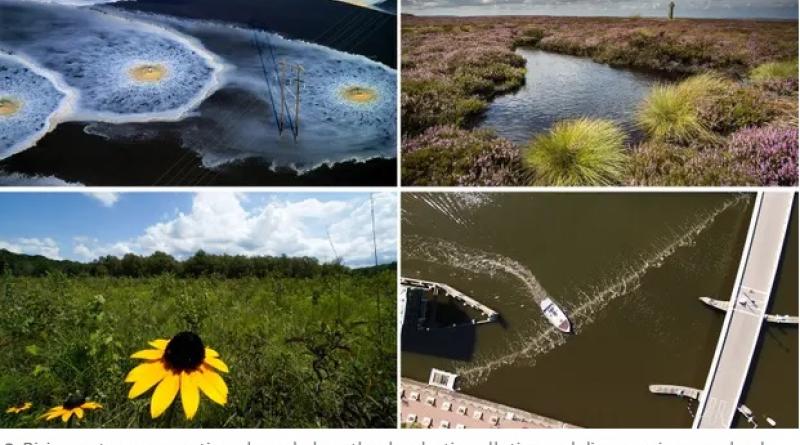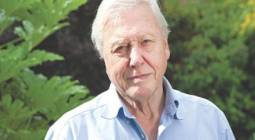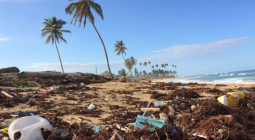Bogs, banks and bubble barriers: five great projects to protect nature

Across the world conservation groups, researchers and volunteers are working to combat the five key drivers of biodiversity loss identified by scientists
1. Saving grasslands
The names running glade clover, cream tick-trefoil and Porter’s goldenrod may evoke the riotous colours of a summer meadow in bloom, but these particular plants are also quietly tucked away in a conservation seed bank that it is hoped will ensure the future of North America’s grassland plant populations.
Changes in land and sea use is the key driver of biodiversity loss in the world – and grassland loss is “the single greatest conservation issue currently facing eastern North American biodiversity”, according to the Southeastern Grasslands Initiative (SGI) at the Center of Excellence for Field Biology, Austin Peay State University, which is working to conserve and restore this crucial ecosystem.
Last year it launched a conservation seed bank (CSB) to preserve vulnerable populations of rare and declining grassland species. Cooper Breeden, the SGI’s plant conservation manager, says: “One of the reasons we decided to pursue the CSB was because the loss of our rare plant populations is outpacing efforts to conserve them in many cases, though not for lack of effort. There is simply not enough funding and capacity for conservation.
“We sought to fill the gap by endeavouring to collect the rare and declining grassland species of the south-east, especially targeting those populations that are particularly vulnerable and currently not receiving much conservation attention.”
Since August 2020, the team has squirrelled away more than 35,000 seeds in 66 collections of 29 species.
But SGI’s work does not stop at banking seeds. “Ideally, we try to conserve populations where they occur,” says Breeden. “The ultimate goal of these collections is to support the survival of populations in the wild.”
The next stage is an interactive map that will allow users to see which species are in the seed bank and where they came from. “The goal in making some of our collection data easily accessible to the public is that it could serve as a resource for our partners involved in grasslands conservation in the region,” he says.
“As the capacity of our conservation community grows, there will be increasing opportunities to put these seeds back in the ground.”
2. Recycling wastewater
Sixty billion tonnes of renewable and non-renewable resources are extracted globally each year, which makes the direct exploitation of resources, alongside the exploitation of organisms, the second biggest driver of biodiversity loss. When it comes to water, consumption has been increasing worldwide by about 1% a year since the 1980s, and global water demand is expected to continue increasing at a similar rate until 2050, according to the UN World Water Development Report 2019.
Desalination plants have been the focus of attention, but as cities and towns from California to Sydney battle drought and water shortages they are turning to the likes of Israel and Singapore for guidance on how to recycle wastewater. Globally, 80% of wastewater currently flows back into the ecosystem without being treated or reused.
Over decades, Israel has invested heavily in the treatment of wastewater, alongside desalination plants, recycling nearly 90% through sewage treatment facilities, which redirect the treated water to irrigation. The sludge byproduct is used as fertiliser and to generate biogas.
In Singapore, five NEWater plants meet up to 40% of the country’s water needs by recycling, according to the national water agency. By 2060, NEWater is expected to meet up to 55% of demand. Its 48km-long deep tunnel sewerage system (DTSS), a used water superhighway, carries used water to reclamation plants to be treated and purified into reclaimed water, or discharged into the sea. When a second phase of the project, currently under way, is completed, pumping stations and conventional water reclamation plants will be phased out, freeing up land.
3. Protecting peatlands
They neither sound glamorous nor hog the limelight, but bogs and peatlands hold one of the keys to combatting the climate crisis. While peatlands cover only 3% of the global land surface, they store nearly 550bn tonnes of carbon – twice as much as in all the world’s forests.
About 10% of the UK is covered in peatland. However, much of this is degraded, and estimates suggest that UK peatlands could be emitting the equivalent of 23m tonnes of carbon dioxide a year. Restoring degraded peatlands could stop these emissions and create biodiversity benefits for wildlife, including plants, birds and insects.
The Great North Bog – which includes four national parks, three areas of outstanding natural beauty, and the proposed South Pennines Park – represents about 92% of the upland peat in England and is one of the main UK restoration projects.
The project, led by the North Pennines AONB Partnership, the Yorkshire Peat Partnership and the Moors for the Future Partnership, is aiming to restore nearly 7,000 sq km of upland peat, which store 400m tonnes of carbon. Damaged peat in the Great North Bog currently releases an estimated 4.4m tonnes of carbon annually but project organisers hope that “by joining up some of the most successful peatland restoration organisations in Europe we can bring about a massive and urgent step change in saving the majority of England’s upland peatlands before it is too late”.
4. Tackling plastic pollution
Scientists have predicted that in the next 20 years the amount of plastic waste in the oceans is likely to nearly triple in volume, from an estimated 8m tonnes a year today to 29m tonnes by 2040. There is no single solution to the plastic crisis, but scientists, inventors and volunteers across the globe are looking at myriad ways to overcome it.
A team at the Nicholas Institute for Environmental Policy Solutions at Duke University in the US is trying to gather all this information in a “plastic pollution prevention and collection technology inventory”. Among the 52 technologies included so far are the Great Bubble Barrier, where “tubes placed diagonally across the bottom of the waterway create a bubble barrier by pumping air, creating a current that brings debris to the surface and guides it to a catchment system”; the Holy Turtle, a 1,000ft floating unit which is towed by two marine vessels and captures floating waste; and Stow it, don’t throw it, a youth-driven initiative that recycles tennis ball containers into fishing line recycling bins for anglers.
Zoie Diana, a PhD candidate in the marine science and conservation department at Duke University and one of the team behind the inventory, says they are aiming to add more than 40 new technologies by early next year. “We hope that our study and inventory serve as a tool to prevent plastic from entering waterways and collect existing pollution, complementing ongoing efforts to reduce the generation of plastic pollution further upstream in its life cycle.”
5. Dealing with invasive species
At least 107 highly threatened birds, mammals and reptiles are estimated to have benefited from invasive mammal eradication on islands, according to a study published in 2016. “Although still few and spatially localised, such cases show that with prompt and appropriate action, it is possible to reduce human-induced extinction rates,” the Intergovernmental Science-Policy Platform on Biodiversity and Ecosystem Services (IPBES)’s global assessment noted.
New Zealand is at the forefront of this action and has committed to eradicating stoats, possums and rats by the middle of the century under its Predator Free 2050 plan, using a mixture of trapping, hunting, poison and technology. But it is also trialling other projects. A purpose-built predator exclusion fence has been erected to protect 6,000 sq metres of prime habitat for the endangered robust grasshopper, thought to be the world’s first fenced habitat designed for an insect.
The aim of New Zealand’s Predator Free 2050 is to “return the voices of the insects, bats, reptiles and birds back to the forests, farmland, towns, cities and coasts”. Currently, 74% of the country’s native terrestrial birds, 84% of its native reptile species and 46% of vascular plant species are threatened with extinction, or at risk of becoming threatened, according to the Department of Conservation. But in the five years since Predator Free 2050 was launched, the numbers of birds such as kea, kākā, kākāriki, the Antipodes snipe and the Tūī have all increased, according to a five-year progress report.
Find more age of extinction coverage here, and follow biodiversity reporters Phoebe Weston and Patrick Greenfield on Twitter for all the latest news and features





